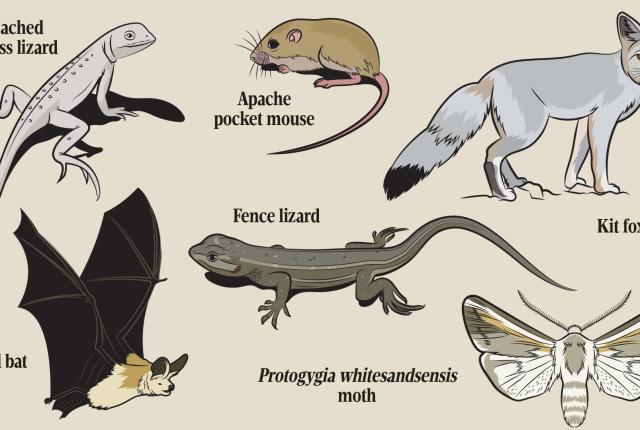Illustration by Jameson Simpson.
THE DUNES THEMSELVES ARE ONLY about 10,000 years old, just a blink of an evolutionary eye, which makes the number of species adapted to this landscape astonishing. Take lizards. Of the 20 species that live in the Chihuahuan Desert, three of them evolved at White Sands, becoming whiter to remain cool and as camouflage from predators.
“Not only are they adorable and totally cool to look at,” says Erica Bree Rosenblum, an associate professor of environmental science at the University of California at Berkeley who studies lizards at White Sands, “but from a biological standpoint, they’re really, really interesting for learning how evolution works and how quickly animals can adapt when conditions change.”
Bleached earless lizard
Found in the interdunal areas, the bleached earless lizard is the whitest of the three species living in the dunes and identifiable by the black spots on either side of its head. “They’re the most camouflaged,” says Rosenblum. “You have to almost see them by movement, because otherwise it’s too hard to look for them.”
Fence lizard
Often perched on yucca stalks, this white variety of lizard with black stripes and blue accents uses its coloration to hold its territory against other males or to entice females. “They have these really bright blue bellies they use to communicate with one another,” says Rosenblum. “So sometimes you see them doing little push-ups.”
Kit fox
The largest animal in the dune field, the kit fox weighs only about five pounds. Often found in the shrublands and the dunes, kit foxes tend to be a little lighter in color and have adapted better to White Sands than their canid relative the coyote. “They’re able to live on a much smaller prey base, so can live in places where the coyotes cannot,” says Gary Roemer, a mammal researcher with New Mexico State University.
Pallid bat
About four inches long, with large ears, these sand-colored bats often roost at the park’s visitor center. “Unlike many bat species that catch flying insects, pallid bats fly low and seek to catch insects moving along the ground,” says Jeremy Lane, New Mexico Department of Game and Fish’s public information officer.
Apache pocket mouse
This tiny mouse lives out its entire life without ever needing a drink of water, instead absorbing it from the Indian rice grass seeds it eats, which it packs into its mouth “pockets.” Although it’s nocturnal, the pocket mouse has white fur (surprise: It helps to be white even at night on the dunes). “The funny thing about all the white species: They’re not albino,” says David Bustos, resource program manager with the park. “They keep the pigment.”
Protogygia whitesandsensis moth
Found in the southeast corner of the park, the largest of the dunes’ endemic moth species is 1.5 inches across, is dark in color, and—unique among moths—flies only in winter. “I hypothesize the darker-colored wings allow the moth to absorb solar energy during the short winter days, thereby allowing it to fly into the very cool evenings,” says Eric Metzler, a moth collector and researcher who has found them even after the temperature falls below freezing.

Read More: Prehistoric Footprints at White Sands Tell Rich Stories


